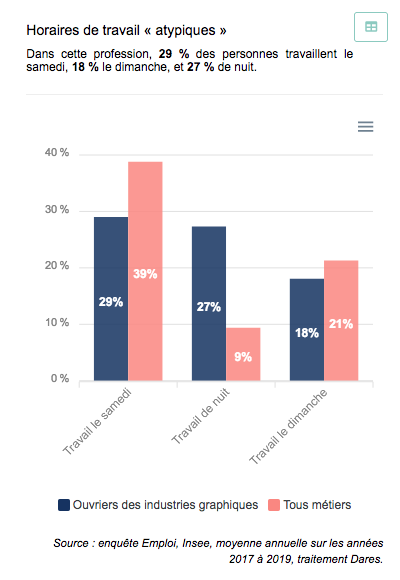Changes in employment status, hours and wages
The status of employment in the graphic industries (skilled and unskilled workers) is becoming more fragile. The Dares, which published "Statistical Portraits of Occupations" in April 2021, reports that 89% of graphic industries workers had an open-ended contract in the early 1980s (1982-1984), compared to 72% today (2017-2019). Over the 2017-2019 period, there are 50,000 graphic industry workers.
The profession involves atypical working hours, with 29% working on Saturdays, 18% on Sundays and 27% at night. These atypical hours are nevertheless lower than the average for all occupations, as shown in the table below published in the Dares study.

The average net salary was 1707 euros in 2017-2019. It increased by 29% between 2003-2005 and 2017-2019, which corresponds to an average increase of 1.9% per year. Taking inflation into account, the salary increased by 0.6% on average per year, says Dares.
Who are the employers?
Dares categorizes graphic industry workers into a family composed of two occupations: unskilled workers in printing, press and publishing; and skilled workers in printing and finishing in the graphic industries.
In this family, 71% of employees work in the wood, paper and printing industries; 10% work in publishing, audiovisual and broadcasting; 4% in the manufacture of rubber and plastic products; and 15% in other sectors.
Fifty-four percent of employees work in the private sector in establishments with 50 to 500 employees; 28% in establishments with 10 to 50 employees; 9% in establishments with less than 10 employees; 4% in establishments with more than 500 employees; and 3% for the State, hospitals and local authorities.
In 2020, the sector had 7090 category A job seekers. Of these, 51% have been registered for one year or more and 35% are women, according to Dares.













